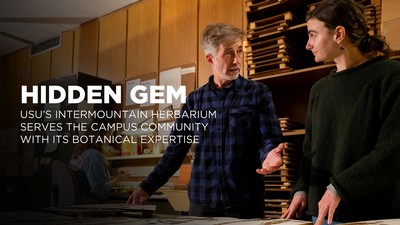Animals, the Keepers of Natural Climate Change Solutions?
By Traci Hillyard |
Utah State University watershed science and ecology professor Trisha Atwood.
What does your favorite wild animal, a wildebeest, a wolf, and a sea otter have in common? Among many similarities, these and other wild animals affect the carbon cycle. And in case you need another reason to appreciate wild animals more, scientists suggest that animal effects on the carbon cycle could lead to natural solutions that might slow climate change.
All herbivorous (plant-eating), carnivorous (meat-eating), and frugivorous (seed-eating and dispersing) animals in land or marine environments directly and indirectly affect ecosystems through behaviors and biological processes, such as eating, breathing, excreting and roaming around landscapes. These zoogeochemical effects impact the carbon cycle and how carbon is used, stored, and exchanged across land and seascapes.
This point is precisely what makes Utah State University watershed science and ecology professor Trisha Atwood and her colleague’s new scientific review so significant. Current Earth system models use remote-sensing technology to predict future climate change and what it will look like on Earth. While these models show how carbon transfers from soil reserves to plants through photosynthesis and respiration, “surprisingly, they don’t account for animals at all,” says Atwood. “Earth system models can be inaccurate because they are missing part of the story.”
Carbon (C) is an essential, abundant element that is continuously circling in the Earth’s system. It is stored in and makes up the basic building blocks of soils, plants and animals—including humans. Plants take up C from the carbon dioxide in the atmosphere and release oxygen through photosynthesis and respiration. Herbivorous animals consume plants and carnivorous animals prey on herbivores and then store C in their biomass. Some of this C is respired and returned to the atmosphere as carbon dioxide. Additional C is stored in soils as waste products. Carbon dioxide (CO2) functions as a greenhouse gas, trapping heat on the Earth’s surface. Thus animals contribute and mediate the carbon cycle.
Atwood and her colleague’s note that limitations from past technology and the complex movements of wild animals across sea and landscapes have kept scientist from fully understanding and including the impact of animals on the carbon cycle. They reviewed marine and land animal studies that demonstrate how small studies in real and artificial systems have worked to show animal carbon use and storage at a local, small scale; however, Atwood declares, “if we really want to get this information, we need to go bigger.”
Fortunately, Atwood and colleagues outline and call future researchers to design studies using new LIDAR (Light Detection and Ranging) remote-sensing technology combined with spatial ecosystem mapping and direct on the ground animal studies. Together, this technology and research could show a more nuanced view of how sea and land animals mediate carbon between the atmosphere and across sea and landscapes and suggest how to manage land and marine spaces and animals for healthy carbon cycling and storage.
WRITER
Traci Hillyard
Administrative Assistant
College of Science
435-797-2478
traci.hillyard@usu.edu
CONTACT
Trisha Atwood
Associate Professor
Department of Watershed Sciences and Ecology Center
trisha.atwood@usu.edu
TOPICS
Research 888stories Ecology 174stories Climate 152stories Ecosystems 131stories Solutions 64storiesComments and questions regarding this article may be directed to the contact person listed on this page.






